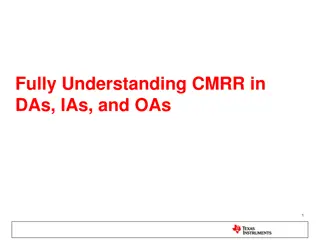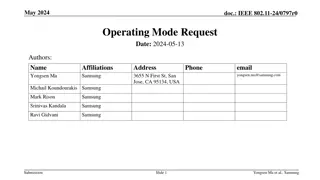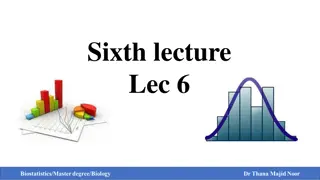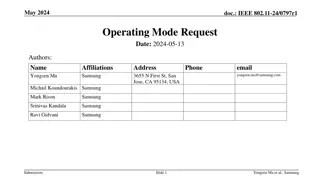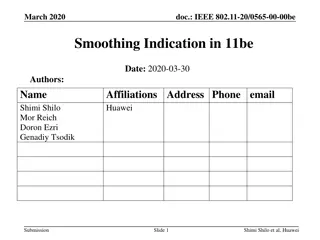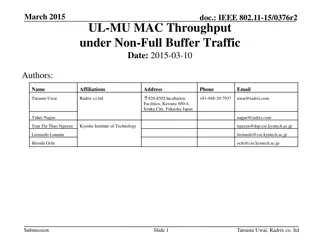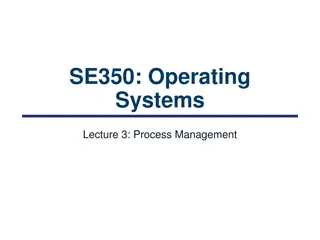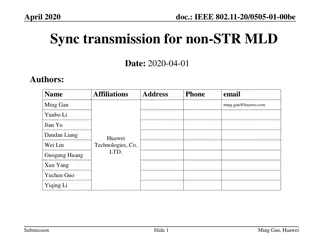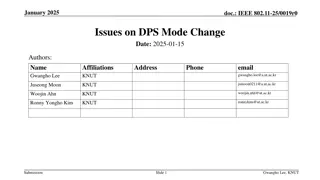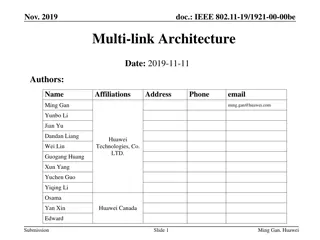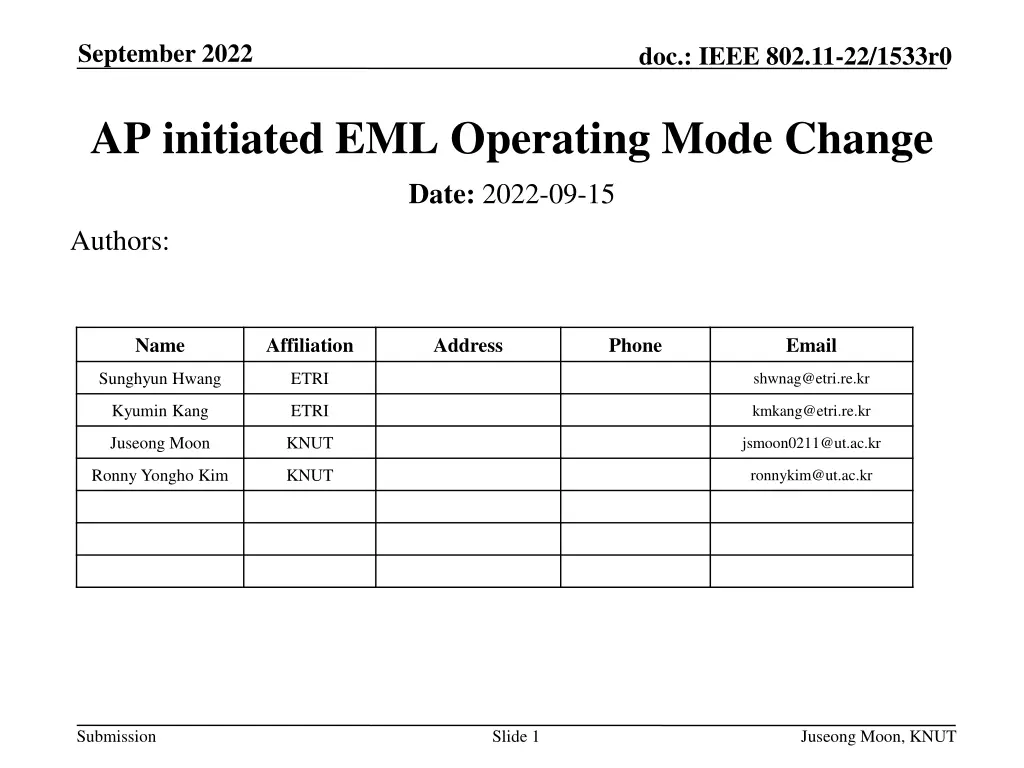
Enabling Efficient EML Operating Mode Changes in IEEE 802.11-22
Explore the intricacies of EMLSR operation in IEEE 802.11-22 regarding TID-to-Link mapping changes, emphasizing the need for AP-initiated methods to streamline EML operating mode modifications. Efficiency improvements and communication implications for non-AP STA MLDs are discussed in detail.
Download Presentation

Please find below an Image/Link to download the presentation.
The content on the website is provided AS IS for your information and personal use only. It may not be sold, licensed, or shared on other websites without obtaining consent from the author. If you encounter any issues during the download, it is possible that the publisher has removed the file from their server.
You are allowed to download the files provided on this website for personal or commercial use, subject to the condition that they are used lawfully. All files are the property of their respective owners.
The content on the website is provided AS IS for your information and personal use only. It may not be sold, licensed, or shared on other websites without obtaining consent from the author.
E N D
Presentation Transcript
September 2022 doc.: IEEE 802.11-22/1533r0 AP initiated EML Operating Mode Change Date: 2022-09-15 Authors: Name Affiliation Address Phone Email Sunghyun Hwang ETRI shwnag@etri.re.kr Kyumin Kang ETRI kmkang@etri.re.kr Juseong Moon KNUT jsmoon0211@ut.ac.kr Ronny Yongho Kim KNUT ronnykim@ut.ac.kr Submission Slide 1 Juseong Moon, KNUT
September 2022 doc.: IEEE 802.11-22/1533r0 Abstract CID 12410, 14077, 10157, 10158: In certain cases, such as link disablement, etc, AP may need to change EMLSR links with EML OMN procedure. TID-to-Link mapping may not match with EMLSR Links, when AP MLD changes TID-to-Link mapping (especially, group based TID-to-Link mapping) In document 22/1023r5[1], AP Link Disablement, TGbe discussed about broadcast TID-to-Link mapping method IEEE 802.11be needs to define AP initiated EML Operating Mode changing method Submission Slide 2 Juseong Moon, KNUT
September 2022 doc.: IEEE 802.11-22/1533r0 Issue From 11/1023r5, Page 22 and 23: An AP MLD may advertise a mandatory TID-to-link mapping by including a TID-To-Link Mapping element in the Beacon and Probe Response frames that the APs affiliated with the AP MLD transmit. At the time indicated by the Mapping Switch Time field of a TID-To-Link Mapping element in a Beacon or a Probe Response frame received by a STA affiliated with a non-AP MLD from an AP affiliated with its associated AP MLD, the non-AP MLD shall update its TID-to-link mapping according to the rules that establish a TID-to-link mapping in this subclause and with the consequences of the updated mapping defined in 35.3.7.1.1 (General). If broadcast TID-to-Link mapping is applied, EMLSR Operation in relation with TID-to-Link mapping might be affected. Submission Slide 3 Juseong Moon, KNUT
September 2022 doc.: IEEE 802.11-22/1533r0 Issue (Continued) EMLSR Operation on Link 1, 2 AP MLD Link 1 Time Non-AP MLD TID to Link mapping Broadcast TID to Link mapping AP MLD Link 2 Time Non-AP MLD TID X: Link 1, 2 TID X: Link 3 TID X Frame (Can not transmit) AP MLD Link 2 Time Non-AP MLD When TID-to-Link mapping is changed, in a certain case, EML Operating mode (EMLSR links) should be reconfigured. If there are many EMLSR operating non-AP STA MLDs, that are affected from changed TID-to-Link mapping, it s inefficient for the non-AP STA MLDs to send unicast EML OMN frames. Before EML OM reconfiguration, communications for some TID(s) can be blocked due to newly changed TID-to-Link mapping. AP initiated method is needed to enhance the inefficiency of unicast STA initiated MLD OMN procedure. Slide 4 Submission Juseong Moon, KNUT
September 2022 doc.: IEEE 802.11-22/1533r0 AP Initiated EML Operating Mode EMLSR Operation on Link 1, 2 EML OMN (Broadcast / Unicast) A c k AP MLD Link 1 A c k Time Non-AP MLD EML OMN TID to Link mapping Broadcast TID to Link mapping AP MLD EMLSR Operation on Link 2, 3 Link 2 Time Non-AP MLD TID X: Link 1, 2 TID X: Link 3 TID X Frame AP MLD Link 2 Time Non-AP MLD After TID-to-Link mapping is changed via broadcast method, AP MLD may Send unicast EML OMN frames to EMLSR operating non-AP STA MLDs to change or terminate EMLSR operation Send broadcast EML OMN frame to EMLSR operating non-AP STA MLDs to change or terminate EMLSR operation Submission Slide 5 Juseong Moon, KNUT
September 2022 doc.: IEEE 802.11-22/1533r0 Conclusion We discussed AP-initiated EML Operating Mode changing method. When TID-to-Link mapping is changed by an AP MLD, it s efficient that the AP MLD initiates to reconfigure EML operation. Submission Slide 6 Juseong Moon, KNUT
September 2022 doc.: IEEE 802.11-22/1533r0 References [1] 802.11be, Pooya Monajemi, 22/1023r5, AP Link Disablement Submission Slide 7 Ronny Yongho Kim, KNUT



